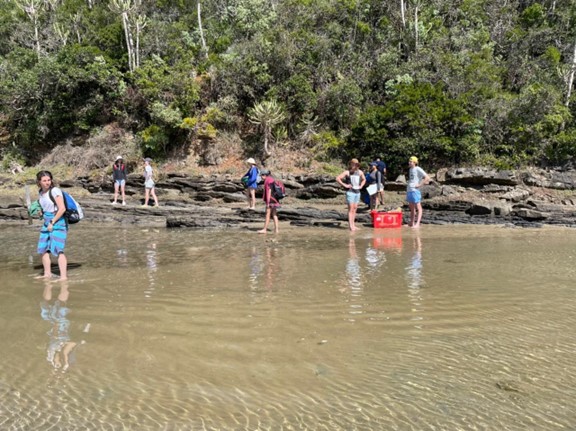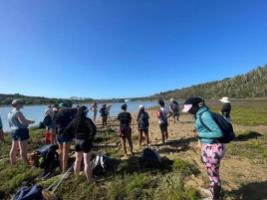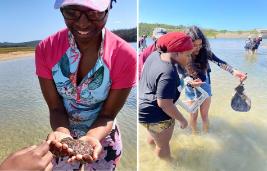
At Rhodes University we are fortunate to have a myriad of beautiful and pristine ecosystems on our doorstep. This facilitates field-based learning activities, which are key components of many of our undergraduate and postgraduate courses. The ZOO302 (Marine Biology) course is no exception, with a day long field trip to the Kariega Estuary comprising the field component of this module. This c field trip is designed around reinforcing theoretical concepts in nearshore and estuarine marine ecology, and additionally serves as an opportunity for students to collect their own samples for processing in the laboratory. More importantly, the field trip offers the students the opportunity for out of classroom learning experience.
We departed from the Departmental parking lot and were on the road by 8.30AM and arrived at the Estuary well before 9.30AM. The weather was perfect, characterized by minimal wind and cloud cover, and peachy atmospheric temperatures. The water in the estuary was a little cold, given oceanic conditions, but warmed up as the tide started to drop and the day wore on.
Once on site, Prof. Froneman and Prof. Wasserman gave a recap of in-class content as it related to the Kariega Estuary. Of note, were discussions on the the impact of freshwater abstraction and exploitation on the ecosystem functioning of the estuary and the importance of salt marsh habitats in temperate-climate estuaries. The students were split into two groups. Group 1 was tasked with examining the importance of submerged macrophytes (seagrass) as a habitat for invertebrates, While Group 2 assessed the difference in fish communities between the main channel of the estuary and an adjacent small creek.

Salt marsh littoral communities were discussed within the context of their contributions to stabilizing littoral zones and role in detrital food web dynamics.
Group 1 observed that the seagrass represents an important habitat for a large numbers of different invertebrate species including sea hares, crowned crabs, shrimp and snail, most likely due to fact the beds offer a refuge against predation and are characterized by increased food availability. Group 2 quickly realized that the creek samples contained considerably more fish than did the main channel. These findings were discussed within the context of sampling gear efficiencies, ease of attaining representative samples between sites and fish size effects on gear avoidance. The main findings of the field trip will form part of the class mark in the form of a practical write-up that each student will have to submit for assessment

A fearless 3rd year students holding a Sea hare (left) and a dead electric ray (right). Prof. Froneman has previously studied sea hares, looking at the role of secondary metabolites as anti-predatory defense mechanisms. The students also managed to find a decaying electric ray, and were simply not scared to pick the stinky fish up for closer examination. The students thoroughly enjoyed encountering these fascinating animals and gained an appreciation for fundamental historic and ongoing research within the Department of Zoology and Entomology.

The Marine Biology class of 2022. All students engaged fully with the environment, their peers and lecturers.
